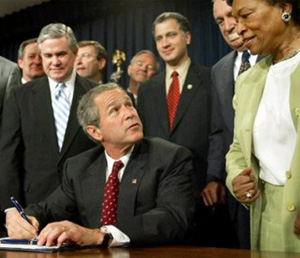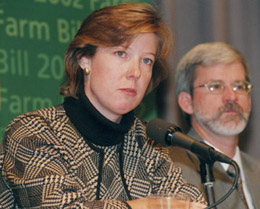|
Legislative Affairs
Major activities carried out during
2002.
 eadership and vision exercised by the NCC three years ago
resulted in passage of The Farm Security and Rural Investment Act of
2002. The farm law contained principles developed by a NCC
Leadership Group appointed in late 1999. Those principles were
pursued vigorously throughout the entire policymaking and
legislative process, culminating in a cotton program that will
improve the farm income safety net and competitive position of U.S.
cotton. eadership and vision exercised by the NCC three years ago
resulted in passage of The Farm Security and Rural Investment Act of
2002. The farm law contained principles developed by a NCC
Leadership Group appointed in late 1999. Those principles were
pursued vigorously throughout the entire policymaking and
legislative process, culminating in a cotton program that will
improve the farm income safety net and competitive position of U.S.
cotton.
Just as policy objectives were important, so was
adequate funding and timely implementation of the new legislation.
Lawmakers were encouraged to pass new legislation even though the
FAIR Act had one more year to run. Once the final bill was passed,
USDA moved quickly to develop implementation rules for a bill that
in many ways was quite different from the 1995 Act.
The NCC’s
2002 year began with a unified and focused effort to repel payment
limit amendments. After Congressional members were apprised of the
negative impacts of such changes, several state delegations signed
letters urging rejection of any measures that would unfairly target
commercial-sized cotton operations. Southern Cotton Growers and
Plains Cotton Growers delegations went to Capitol Hill, where they
were joined by every major commodity group and most general farm
organizations in opposing the payment limit amendments. Cotton Belt
bankers also joined the effort by communicating the impact of
payment limits on production financing.
American Cotton
Producers Chairman Mark Williams was joined by representatives of
other producer and cooperative interests in expressing concerns with
the Grassley-Dorgan amendment to key Senators. This appeal was
reinforced by a coalition of cotton and textile industry
associations. Eventually, several Senators co-signed a letter from
Senator Blanche Lincoln (D-AR) urging Senate farm bill conferees not
to include such language in their farm legislation.
Chairman
Hood conveyed U.S. cotton’s priorities on farm law, trade and
appropriations to key Congressional members and the Administration.
His message included a request for adequate and stable funding for
commodity programs.
To remove uncertainty about the 2002
crop, quick Congressional approval of the House/Senate Conference
farm bill agreement was urged. House Cotton Belt conferees Larry
Combest (R-TX), Charles Stenholm (D-TX), Saxby Chambliss (R-GA),
Richard Pombo (R-CA), Terry Everett (R-AL), Frank Lucas (R-OK) and
Cal Dooley (D-CA) worked to ensure that cotton’s priorities were
addressed in the legislation. On the Senate side, Cotton Belt
conferees Thad Cochran (R-MS) and Jesse Helms (R-NC) played
important roles in shaping the final product. Majority Leader
Daschle (D-SD) helped steer the Conference Committee toward a
workable compromise. Although not members of the conference,
Senators Lincoln (D-AR), Zell Miller (D-GA), John Breaux (D-LA),
Mary Landrieu (D-LA), John Edwards (D-NC), Jean Carnahan (D-MO) and
Ernest Hollings (D-SC) kept Senate leaders focused on cotton’s
priorities and producing workable legislation.
House
Agriculture Committee Chairman Combest, with the help of Rep.
Stenholm, successfully guided new farm legislation through
Conference and the House, capping an effort that began in 2000 with
nationwide input hearings. Senate approval followed quickly. The
bill maintains key elements of the FAIR Act, such as direct
payments, the marketing loan, the three-entity rule and marketing
certificates. Important new provisions include countercyclical
payments and the option of retaining or updating current AMTA base
acres and program yields on those payments. President Bush signed
the bill after passage and noted that it offered farmers and
ranchers a better safety net and was consistent with U.S. trade
obligations.
 |
|
NCC Chairman Kenneth Hood (in back of room) was among
those witnessing President Bush sign the Farm Security and
Rural Investment Act of
2002. | NCC
immediately arranged and conducted more than 40 meetings across the
Cotton Belt to review the law’s key provisions. The resulting
producer input was provided to USDA, as were NCC comments to the
agency’s proposal for changes.
Even before the new farm law
could be implemented, it drew criticism from the national news
media, fueled largely by misleading information posted on the
Environmental Working Group’s web site. A June 26 Wall Street
Journal article charged that U.S. subsidies were creating a world
cotton glut and damaging foreign cotton farms. The NCC responded to
this and other misinformation. Industry members were supplied with
guest editorials, columns and fact sheets for help in rebutting
misleading and negative press in their communities. Dr. Mark Lange
also countered the unjustified criticism of the cotton program at an
International Cotton Advisory Committee forum in
Washington.
This information, along with numerous NCC Action
Requests, was placed on the NCC’s web site. Site upgrades were made
to ensure www.cotton.org remained the premier central online
information source about the U.S. cotton industry. NCC economists
created a web-based worksheet to assist growers in assessing their
alternatives regarding base acres and program yields under the new
law.
Chairman Hood also promptly invited commodity and
general farm organizations from the Commodity Roundtable to develop
a coordinated farm bill defense plan. Realizing that changing public
opinion on farm policy was a long-term and expensive process, the
Commodity Roundtable group agreed on the need to continue
communicating the benefits of U.S. agriculture policy. The NCC
already had in place a parallel effort in the "Cotton Counts"
consumer awareness campaign carried out by the National Cotton
Women’s Committee to increase appreciation of the U.S. cotton
industry.
Roundtable participants conveyed their support for
the new farm law with selected Congressional members and issued a
statement during a Washington news briefing that urged no changes be
made to that legislation. During the July 4 recess, industry leaders
and agricultural financial institutions urged Congressional members
to work actively in opposing harmful amendments.
At the NCC’s
request, Secretary of Agriculture Veneman announced an initial
advance counter-cyclical payment for the 2002 crop at the maximum
allowable rate with a second advance payment to be made available in
February 2003 if USDA projected that effective prices would remain
below the target price.
 |
|
Alabama cotton producer Larkin Martin stressed that a third
party Technical Service Provider system is vital to the
success of conservation programs during a NRCS Summit in
Washington, DC. |
The NCC also was an advocate for a workable conservation title.
Educational tours were provided for key Congressional and Natural
Resource Conservation Service staff to help them in their
development of the new Conservation Security Program. NRCS was urged
to deem no-till and strip-till as acceptable practices for resource
management under the program and to implement it in a farm friendly
manner. Alabama producer Larkin Martin participated in a NRCS Summit
and stressed that a third party Technical Service Provider system is
vital to the success of conservation programs. NCC staff and several
regional cotton organizations also participated in the National
Conference on Farm Bill Conservation Opportunities to hear from NRCS
on the latest program developments and discuss conservation
opportunities.
In other key legislative matters, the
NCC:
|

|
|
Untimely rains and hurricanes disrupted harvest
and hurt cotton production in many areas of the Mid-South and
Southeast. |
| |